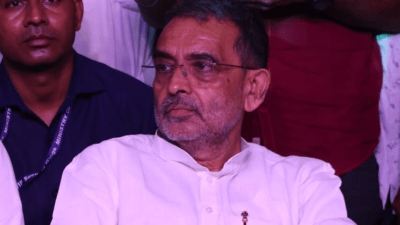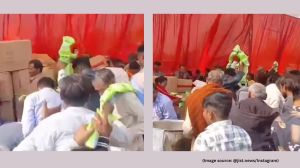Sometime in 2013 while the imam of the Nizamuddin Dargah, S Mehboobul Islam Nizami was pondering over how to restore the Jamaat Khana Masjid within the premises of the dargah complex, he started observing the work being carried out in the adjacent Humayun’s Tomb. The 16th-century magnificent structure, one of the greatest artistic achievements of the Mughal Empire located in the heart of Delhi, had been declared a World Heritage Site in 1993. Soon after the restoration of the tomb gardens was carried out by the Aga Khan Trust for Culture (AKTC) as a gift from the Aga Khan to India on its 50th year of Independence. In 2007, the AKTC embarked on the conservation of the Humayun’s Tomb itself and by 2013, a newly conserved Humayun’s Tomb was opened up to visitors and Nizami, impressed by what he saw, invited the trust to conserve the mosque, which is part of one of the largest clusters of medieval monuments in Delhi, and in its courtyard is buried the great Sufi saint Hazrat Nizamuddin Auliya.
The AKTC had already been working in the Nizamuddin area for the past five years by then. In 2007, the AKTC in collaboration with the Archaeological Survey of India (ASI) and the South Delhi Municipal Corporation (SDMC) embarked upon an ambitious project for the urban renewal of the larger Nizamuddin area surrounding the Humayun’s Tomb. Apart from the Humayun’s Tomb, the AKTC started out with the conservation of the Ghalib’s Tomb, the 17th-century monument Chausath Khamba, a 700-year-old stepwell or baoli inside the Nizamuddin Dargah, among others. In the last decade and a half, the AKTC has conserved about 60 monuments in the vicinity, the most recent being the 16th-century turquoise domed tomb located on Mathura Road called Sabz Burj, which was opened for public view in November 2021.

Using culture and heritage
While heritage conservation is the core of the AKTC’s work, their approach and philosophy mark them out. “Our aim is to improve the quality of life,” says Ratish Nanda, CEO of the AKTC. “We are demonstrating how conservation and development can go hand in hand,” he adds.
Nanda explains that in 2005-06 the Indian government asked the trust to choose from 50 sites to implement a large conservation project. The Humayun’s Tomb-Nizamuddin area was chosen since it was one of the largest ensembles of medieval buildings in India and has the potential to also create a city park. Its significance comes from the fact that it is home to the mausoleum of the 14th-century saint Hazrat Nizamuddin Auliya who chose to establish his khanqah at Ghiyaspur, where the Nizamuddin Basti exists today. For the last 700 years, pilgrims have been visiting the shrine of the saint. Since it was considered auspicious to be buried near the grave of a saint, the area became home to a large number of tombs including that of the Mughal emperor Humayun. “Nizamuddin is the first point of immigration in Delhi for Muslim migrants from UP and Bihar,” says Nanda.
 The Humayun’s Tomb-Nizamuddin area was chosen since it was one of the largest ensembles of medieval buildings in India and has the potential to also create a city park. (AKTC)
The Humayun’s Tomb-Nizamuddin area was chosen since it was one of the largest ensembles of medieval buildings in India and has the potential to also create a city park. (AKTC)
The Nizamuddin urban renewal initiative is part of the Aga Khan Historic Cities Programme, which works on projects in historic areas in a way so as to spur socio-economic and cultural development of the community. The idea is to use culture and heritage as an asset to improve lives in urban, poor, and remote areas. Apart from Nizamuddin, the initiative had carried out similar work in Kabul, Mali, Herat, Lahore, Damascus, Cairo, Aleppo, and Zanzibar among other places.
“All over the world, historic cities are the most developed ones, attracting the largest number of tourists. But in India, wherever there is a historic city, the urban services start to deplenish there,” explains Archana Saad Akhtar, programme director, Aga Khan Trust for Culture. “That is the case in Shahjahanabad, Mehrauli, Benaras and several others. There is very little attempt at improving the quality of life here. Our aim is to revitalise a historic city centre.”
Building trust
Story continues below this ad
The work was fraught with challenges, the first being that of winning the trust of the people living in Nizamuddin. Nizami speaks about the kind of opposition he faced from his community when he invited the AKTC to work on the mosque. “Several people thought that they would be forcefully evacuating people from their houses,” he says. There was also the religious aspect, given that the Aga Khan is also the spiritual head of the Ismaili Shia community and the majority of the population of Nizamuddin Basti are Sunni Muslims. “Many were unsure of our objectives, using religious slurs on team members. But our work has never been focused on any particular religious community. We are interested in using architectural heritage—Hindu, Islamic or British—as leverage for improving quality of life in historic cities,” says Nanda.
The AKTC started building trust in the community with its social development programmes, which include close to 100 individual projects in the last 15 years. One of the earliest social interventions in the area was in education. The programme focused on improving the physical infrastructure of the South Delhi Municipal Corporation school in the Basti, introducing processes of community engagement in the school, faculty development and training in English for adolescents.
The livelihood programmes of the AKTC look at how the 700-year-old heritage of the area can be used for income generation. Insha-e-noor, for instance, was started in 2008 as a women’s enterprise self-help group that uses skills of crochet and embroidery to produce paper and textile products drawing upon motifs and colours represented in the Mughal monuments near Nizamuddin, especially the Humayun’s Tomb. Over the years, more than 100 women from the Basti have found a stable source of income through the initiative.
 Insha-e-noor, for instance, was started in 2008 as a women’s enterprise self-help group that uses skills of crochet and embroidery to produce paper and textile products. (AKTC)
Insha-e-noor, for instance, was started in 2008 as a women’s enterprise self-help group that uses skills of crochet and embroidery to produce paper and textile products. (AKTC)
Then there is Zaika-e-Nizamuddin, also a women’s enterprise initiative, that started out in 2012 to address malnutrition among the children of Nizamuddin. “The idea was to produce low-cost nutritious snacks for the children of Nizamuddin. Over time we started popularising the traditional cuisine of Nizamuddin and now deliver for corporate get-togethers and private parties as well,” says Noor Jahan, 28, who is part of the 11-member self-help group. “People in Nizamuddin have moved here from all around India so the cuisine is also multifaceted. At Zaika we brought together all these different kinds of preparations to develop a cuisine that is unique to Nizamuddin,” she adds.
Story continues below this ad
 Then there is Zaika-e-Nizamuddin, also a women’s enterprise initiative, that started out in 2012 to address malnutrition among the children of Nizamuddin.
Then there is Zaika-e-Nizamuddin, also a women’s enterprise initiative, that started out in 2012 to address malnutrition among the children of Nizamuddin.
Taking part
Shumayila, 24, says that growing up in the Nizamuddin Basti, she would frequently hear her neighbours fearing that the Aga Khan Trust is out to occupy their homes. However, she became drawn to their work when she came across the restored Chausath Khamba in her neighbourhood. “Despite having been born and grown up in Nizamuddin Basti, I had no idea that there was something called the Chausath Khamba near my home or the tomb of Atgah Khan,” she says. In 2017 Shumayila joined the group Sair-e-Nizamuddin, a community heritage walks group that the AKTC started to involve the youth of Nizamuddin Basti to spread awareness about the rich heritage of the area. “Not only did I learn more about the history of Nizamuddin, but the experience also improved upon my confidence level and overall personality,” she adds.
Heritage and social development are also tied up with biodiversity conservation in the work of the AKTC, the biggest example of which is the redevelopment of the Sunder Nursery, a 16th-century park, sprawling across approximately 90 acres, and containing a large number of monuments, six of which are Unesco World Heritage Sites. The park, which has become a centre of attraction for weekend hangouts in the city, was created over a decade and opened to the public in 2018. Nanda explains, “The Sunder Nursery Development since 2008 has included the creation of a 30-acre wilderness zone including a large fenced-off peafowl habitat. The park, with almost 300 species of trees, now attracts 100 species of birds. We have actively planted species to create a secure habitat for the Indian honeybees.”
 The park has become a centre of attraction for weekend hangouts in the city. (AKTC)
The park has become a centre of attraction for weekend hangouts in the city. (AKTC)
Other projects started by the AKTC in the area include a health programme led by the community, a sanitation program, a waste-management programme, and vocational training for the youth among several others.
Story continues below this ad
After 15 years of working in the Nizamuddin Basti, the AKTC is now looking at ways to ensure the sustainability of the projects already taken. “The idea is to ensure that these programs and self-help groups survive beyond our presence,” says Nanda. “That is quite likely to happen as well since we have really empowered the local community here.



 The Humayun’s Tomb-Nizamuddin area was chosen since it was one of the largest ensembles of medieval buildings in India and has the potential to also create a city park. (AKTC)
The Humayun’s Tomb-Nizamuddin area was chosen since it was one of the largest ensembles of medieval buildings in India and has the potential to also create a city park. (AKTC) Insha-e-noor, for instance, was started in 2008 as a women’s enterprise self-help group that uses skills of crochet and embroidery to produce paper and textile products. (AKTC)
Insha-e-noor, for instance, was started in 2008 as a women’s enterprise self-help group that uses skills of crochet and embroidery to produce paper and textile products. (AKTC) Then there is Zaika-e-Nizamuddin, also a women’s enterprise initiative, that started out in 2012 to address malnutrition among the children of Nizamuddin.
Then there is Zaika-e-Nizamuddin, also a women’s enterprise initiative, that started out in 2012 to address malnutrition among the children of Nizamuddin. The park has become a centre of attraction for weekend hangouts in the city. (AKTC)
The park has become a centre of attraction for weekend hangouts in the city. (AKTC)





























